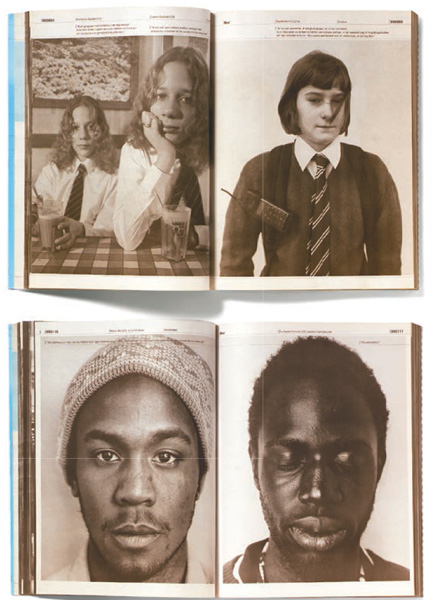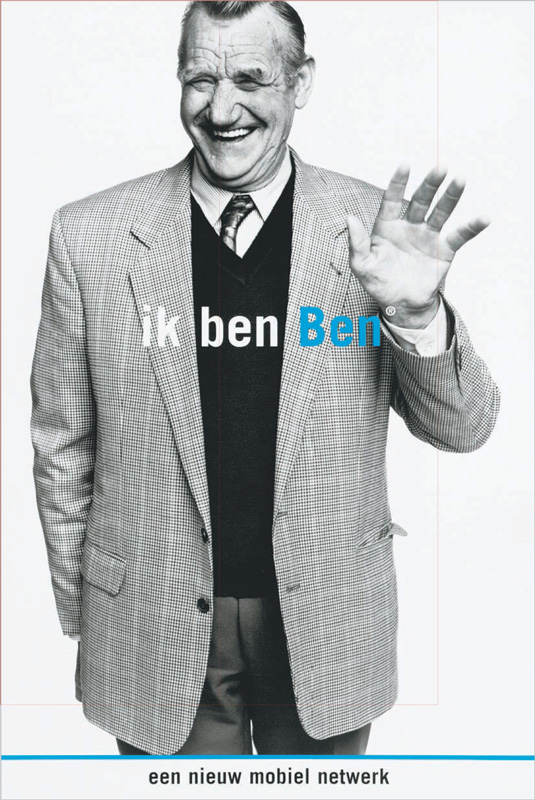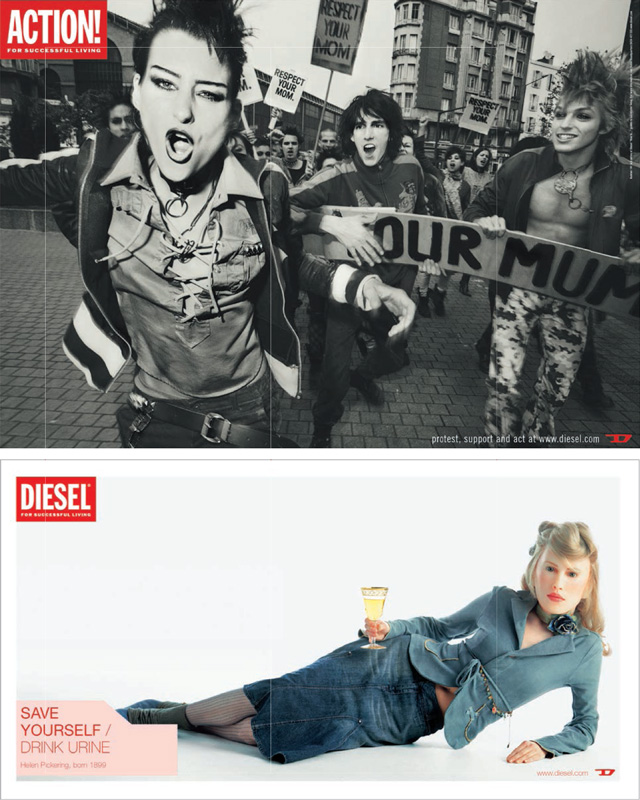INTERVIEW WITH
ERIK KESSELS.
Erik Kessels is creative director and co-founder of KesselsKramer. Here, he talks mobile phones, bad hotels and pushing boundaries through collaboration.
MOBILE PHONES FOR A BETTER WORLD.
“As creative people, our job is simple: to search for unused ground… and then use it. This ‘unused ground’ can be found in execution, in ideas, a certain tone of voice. It’s anything that means escaping from the average, from the mainstream.
“You wish you could do it every day, make advertising for people who don’t like advertising, but you can’t. At most you find it only a few times a year.
“From our own work, Ben is a good example – a campaign where we found ‘unused ground’ within the telecommunications category. Not only did we develop the brand name, identity and campaigns, we helped make mobile phones accessible to the majority of people. We positioned Ben as the mobile brand for everyone, from the elderly to migrants to punks to goths. You saw this in the kinds of people used in the campaigns – not traditional models, but people representing these minority groups.
“In fact, Ben became a mirror for Dutch society and hugely popular, especially amongst those who normally never saw people from their subculture in mainstream advertising. fig. 05 What we especially liked about this approach was that it commented indirectly on a great shift in Dutch politics: over the years that we’ve been running the Ben campaign, the political atmosphere turned from tolerant and progressive to conservative, almost xenophobic. Our client was brave enough to stick to their guns and celebrate the Netherlands’ diversity.
“It would be good if more companies dared to investigate this kind of messaging. Wider cultural concerns are always on their list of values, but you never see them expressed publicly. Just to see these issues addressed in advertising that isn’t government funded would be subversive, but subversive with a point, not just for the sake of it.”




Fig. 05: Early work for Ben, a Dutch mobile phone network that sought to humanize a sector dominated by technology- based messages.
UNUSED GROUND AND UNMADE BEDS.
“Another mostly ‘unused ground’ in advertising is honesty. Absolutely honest ads have appeared every now and again in the industry’s history – VW in the sixties being the most famous example. But still, admitting your faults and telling people about your product as straightforwardly as possible is pretty much virgin territory.
“It’s an area we like, as probably best demonstrated by our work on KesselsKramer’s oldest client: the Hans Brinker Budget Hotel, Amsterdam.
“The Brinker is possibly the worst hotel in the world, a fact we celebrate by describing its many, many faults whenever we can. fig. 06 As a strategy, this isn’t as bizarre as it sounds: because we’re honest, we get through to the Brinker’s young, jaded, suspicious audience. Strangely, by telling people the Brinker is shit, the hotel also gets fewer complaints than you might expect. If a guest knows upfront that they’ll get a stained mattress riddled with bedbugs, what else can they bitch about?
“Irony is at the heart of our Brinker work. The most expected way to make advertising for people who don’t like advertising is humour. We like funny too, but prefer a more dry, self-referential kind of joke, the sort that you’re not sure whether it’s serious or not.
“It’s not an approach that works for every client, but if taking the piss out of advertising is your thing, fairly sarcastic self-reflexive gags are the way to do it.
“Anti-advertising, I suppose, would be the official term, and the Brinker’s a good example.”


Fig. 06: Examples of work for the Hans Brinker Budget Hote KK’s oldest client is famed for its lack of attractive qualities, a fact highlighted in many years of brutally honest campaigns.
PERFECT IS BORING.
“You can use advertising as a mirror to consumers, to reflect real lives, but it’s an opportunity that is almost always missed.
“Normally we do the opposite. Normally advertising is about making everything 100% perfect. There are no mistakes, everyone and everything is flawless. But it’s far more interesting to leave a big mistake in an ad, or to show people who aren’t air-brushed and idealized. That way, we recognize ourselves. fig. 07
“Why is there this love of perfection in advertising? Partly it’s about fear, about not wanting to offend or alienate people by highlighting the less glossy side of life. It’s also because perfection is possible: there’s time, money and will to make every-thing flawless. There’s total control. Ads are perfectly created from bottom-left to top-right, every detail deliberated over and endlessly polished.
“While working on the Diesel ‘Action’ campaign, I tried to select images of models where they aren’t quite as idealized as you might expect. Perhaps the pose would be slightly ‘off’ in some way, or the angle not conventionally flattering. By choosing images like these, you make the campaign slightly more authentic.”


Fig. 07: Samples of KK’s Diesel work. The Italian brand took a critical view on the fashion world, with ads going far beyond the industry standard images of pretty people looking seductive.

Fig. 08 Tibor Kalman poster demonstrating that the convention of “always be positive” can be broken and still result in arresting work.
HUNTING FOR AUTHENTIC.
“Avoid getting your inspiration from advertising. In a way, looking to advertising is pointless. If you see a good idea you can admire it, but it wouldn’t be wise to re-use it.
“It’s better to get your inspiration outside the business. Tibor Kalman is a fine example of someone who did just that. fig. 08 He was prolific in both where he looked for inspiration and what he produced as a result. Kalman made products, books, a magazine and also ads. There you see somebody who is not focused on advertising, and in so doing comes up with much fresher ideas.
“You know you’ve got it right when you’re totally shocked by one of your own ideas. It might happen once or twice a year but it’s the best feeling. You think: ‘Did I just do that?’”
ON FRESH THINKING THROUGH COLLABORATION.
“I wouldn’t go so far as to call this a ‘technique’ for producing original work, but there’s something to be said for collaborating with creatives outside the industry. Industrial designers, photographers, architects and documentary film directors, for instance, who are new to advertising. Often they end up breaking the rules without being aware of those rules in the first place. That’s very refreshing.
“This collaboration wasn’t always possible. Photography is a case in point. At one time advertising photography was confined to a pool of thirty to forty photographers whom all advertising agencies tended to hire. These photographers were good. In fact, they were master copiers, and by hiring them you were guaranteed a high standard of work. They could do everything, except work in their own style.
“Fairly recently, however, more and more outsider photographers began offering their services. Among them were photojournalists and art photographers interested by the power and reach of commercial work. If you allow them freedom, and can keep compromises to a minimum, the results are generally great.
“I remember my first experience of working like this. At the time, Johan Kramer and I were still working in London, before we set up KesselsKramer. I’d always admired the work of a photographer called Simon Larbalestier, the man behind The Pixies’ album covers. By chance, I came across his portfolio, and ended up hiring him for a job for the British government.
“In the end it worked out well but I was incredibly nervous – which is something you have to deal with if you end up working with those you really admire.”
THE COMFORT CONTRADICTION.
“There was a period when I travelled by train every day. After two weeks I started recognizing my fellow passengers and began to feel stuck in a routine. From then on I’d find different ways to enter the station, and different places to stand on the platform, all in order to avoid coming across the same people in the morning. The urge to break these little habits is something I experience quite a lot.
“Getting too comfortable isn’t good. Comfort is what people naturally seek, but if we want to stay true to our desire to produce the best work, it’s best avoided. It means you stop questioning.
“Mind you, it’s probably good to qualify this a bit. You also need to have certain desires met before you get the luxury of restlessly questioning everything. If you look at the countries with the very highest creative output, you also see the very highest levels of material comfort.
The Scandinavian countries or Switzerland are prime examples.
“In these places there’s a certain feeling of fulfilment on a societal level that perhaps leads to boredom at the level of individuals. You get so comfortable that at some point you become uncomfortable again. Then you start making great work.
“Maybe it goes back to Abraham Maslow’s hierarchy of needs: once you have the basics, it’s easier to focus on stuff like creativity, being tolerant and other values we tend to admire.”
KESSELSKRAMER PUBLISHING.
“No matter how many gadgets, widgets and e-readers come out, books seem to remain special to people. It’s like loving books is wired into people’s brains.
“As a company, we’ve always been interested in storytelling for brands, so storytelling through books seemed like a logical step. fig. 09
“Our publishing arm, KesselsKramer Publishing, was created to provide a means for KesselsKramer’s staff to express their creativity through pictures, words and any combination of the two.
“The books we make are treated as interesting objects in their own right, not just a medium for conveying information and ideas. We use all kinds of unusual paper, new types of binding and formats.
“A large part of KK Publishing’s output is in the field of found photography. Also called ‘the people’s camera’ or ‘vernacular photography,’ this area is about collecting and presenting images never intended for public display.
“It’s the opposite of most advertising photography, which is almost exclusively concerned with picture manipulation and very definite agendas.
“The style of KK Publishing’s books filters back into KK’s commercial ventures, inspiring us to find the most genuine, most human side of advertising photography.”


Fig. 09: Examples from KK Publishing, demonstrating an output that includes magazines, photography books and fiction.
